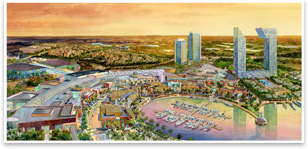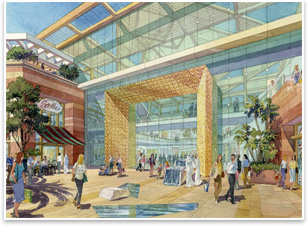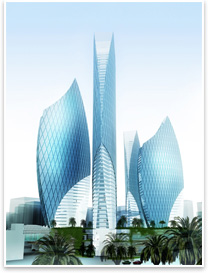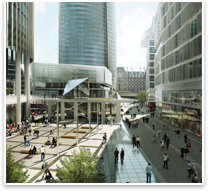
The
World Shrinks, Dubai Grows Summary: The number of U.S. architecture firms doing international work has doubled since 2002. Large firms of more than 100 people and firms that have some specific type of international expertise or connection are the most likely to take on these projects. Firms see expanding internationally as a way to mitigate building downturn risks by increasing their geographic diversity, gain footholds in exponentially expanding markets in the developing world, and detect nascent building industry trends in advance of their domestic presence. In October, the Cityscape Dubai real estate conference brought 45,000 developers, investors, architects, and designers together to buy, sell, and vie for $1.3 trillion of development projects on display. Billed as “the largest business-to-business real estate investment and development event in the world,” the event caters to “institutional investors,” which organizers define as investors ready to drop at least $5 million into the future of the desert city that is rapidly becoming the symbol of global capitalism’s next phase of growth. To attract this money, the world’s premiere architecture firms sponsored booths. One case in point was Zaha Hadid, Hon. FAIA.
As a measure of the increasing globalization of the architecture
profession, the conference has been wildly successful. Since 2005,
this annual conference, held October16–18, has doubled in attendance,
according to the Gulf News, which is almost in lockstep with the
increase in the amount of international work architects are doing.
While international work is still a relatively small part of all U.S. architecture firm billings (6 percent), for large firms with the scale and resources to handle the complexity of work abroad and smaller firms with specialized expertise, the explosive markets in the Middle East, China, India, and elsewhere are the newest frontier. A 2006 AIA firm survey of member-owned firms revealed that among those of 100 people or more, 59 percent had done international work (defined as billings from outside the country for either international or domestic clients and inside the country for international clients) in the past three years.
A design-only firm, 5+Design’s work exemplifies the luxury New Urbanist aesthetic taking hold in the Middle East, with its mixed-use Central Market towers in Abu Dhabi shaped like the bud of an emerging flower, to its Los Angeles-style marina master plan for the Dubai Festival City Zone 8c. From the Dubai convention floor, FXFowle’s Peter Weingarten, AIA, says his firm was able to establish their 12-person satellite Dubai office a year ago with the help of an American expatriate the firm hired who could help them navigate the local regulatory agencies and fees.
Consolidation and mergers have been rampant in the economy and in
architecture as well for the past 15 years, says Baker, and some
firms are using this strategy to expand beyond their domestic borders.
Last summer, high-profile, multi-national mergers of RTKL with Netherlands-based
ARCADIS and Hillier with Scotland-based RMJM saw the European firms
co-opting American architects’ strong design brand identities
in exchange for giving the American companies a wider array of engineering
and planning support services that can offer clients single-stop
shopping across the entire building process. But Baker says most
firms don’t see the jump from national to international as
an intuitive next step. “My sense is that that’s a very
complicated leap,” he says. “It really depends on the
opportunities that present themselves.”
Up-close involvement with these economies can give architecture firms a bird’s eye view of global building industry changes perhaps equal to the cityscape vistas that SOM’s 162-story Burj Dubai will offer visitors. One example of this, says SOM Managing Partner Gene Schnair, AIA, has been the vast improvement in Chinese building materials, especially glass. He says that steep building costs in the U.S. will necessitate the importation of cheaper products, and China is poised to take advantage of this. “A couple years ago we wouldn’t even have considered using Chinese glass products, and now we believe they are [on] par with U.S. products,” he says.
“What’s happening in one particular region of the world is likely to affect us at home,” says Schnair. “We all need to recognize that we’re in a global environment.” |
||
Copyright 2007 The American Institute of Architects. All rights reserved. Home Page |
||
news headlines
practice
business
design
Photo 1: 5+Design’s Dubai Festival City Zone 8c is a 900,000-square-foot
waterfront luxury retail development.
Photo 2: Zone 8c is a further expansion of the Dubai Festival City Zone, a massive mixed use site developed by the Al Futtaim Group.
Photo 3: Abu Dhabi’s Central Market (also by 5+Design) will contain two residential towers and two mid-rise office towers.
Photo 4: KPF’s master plan for the Victoria Transport Interchange in London is a mixed-use site comprising almost 300,000 square feet.
Photo 5: KPF is also designing several of the buildings for the Victoria Transport Interchange.
Photo 6: SOM’s Burj Dubai is now the tallest building in the world.



 Ellis’s
firm’s relatively small size (75 people), makes
5+Design an exception to this statistic. He and his four partners
started the company in 2005 after leaving Jerde Partnership, where
they had specialized in creating large, mixed-use master plans for
overseas clients. With their own firm, they’ve used this same
expertise to get a solid foothold in the Dubai and Abu Dhabi markets.
Since the firm’s founding, partner Arthur Benedetti says their
specialized design capabilities have attracted new clients to them. “We
left the old company without taking anything with us,” he says.
Ellis’s
firm’s relatively small size (75 people), makes
5+Design an exception to this statistic. He and his four partners
started the company in 2005 after leaving Jerde Partnership, where
they had specialized in creating large, mixed-use master plans for
overseas clients. With their own firm, they’ve used this same
expertise to get a solid foothold in the Dubai and Abu Dhabi markets.
Since the firm’s founding, partner Arthur Benedetti says their
specialized design capabilities have attracted new clients to them. “We
left the old company without taking anything with us,” he says.

